


xxxxxBy the early
part of the 19th century the Ashanti Empire, founded in 1689 (W3), had become one of
the most powerful states in West Africa. However, the arrival of
the British along the coast brought about four Anglo-
THE FOURTH ANGLO-
Acknowledgements
Map (Ashanti Empire): from www.britishempire.co.uk/maproom/goldcoast. Prempeh: date and artist unknown. The Fall of the Asante Empire: by the American historian professor Robert B. Edgerton, published New York, 1995. . Asantewaa: date and artist unknown. Map (Ghana): licensed under Creative Commons – https://resourcesforhistoryteachers. wikispaces.com.
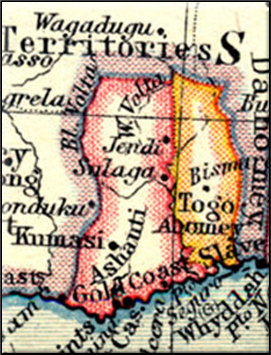 xxxxxThe Ashanti Empire, founded by Osei Tutu in 1689 (W3), had become one of
the most powerful states in West Africa by the early part of the
19th century, stretching from the Togo Mountains in the east to the
Komoe River in the west. However, with the arrival of the British
and the establishment of colonial territories in Sierra Leone, the
Gambia and the Gold Coast in 1821 (G4), its might was challenged and conflict became
inevitable. The British, regarding the Ashanti as a threat to their
coastal settlements and the trade they brought, decided to bring
them to heel, but the Ashanti were no mean fighters, and it was to
take four wars and over 70 years before they were subdued.
xxxxxThe Ashanti Empire, founded by Osei Tutu in 1689 (W3), had become one of
the most powerful states in West Africa by the early part of the
19th century, stretching from the Togo Mountains in the east to the
Komoe River in the west. However, with the arrival of the British
and the establishment of colonial territories in Sierra Leone, the
Gambia and the Gold Coast in 1821 (G4), its might was challenged and conflict became
inevitable. The British, regarding the Ashanti as a threat to their
coastal settlements and the trade they brought, decided to bring
them to heel, but the Ashanti were no mean fighters, and it was to
take four wars and over 70 years before they were subdued.
xxxxxThe
First Anglo-
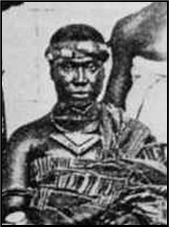 xxxxxThe final confrontation between the two “Empires” -
xxxxxThe final confrontation between the two “Empires” -
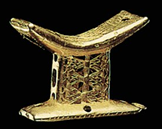
xxxxxIn
1900, however, what the British had seen as a successful invasion
and conquest of the Ashanti Empire turned into a bloody conflict. In
March of that year the colonial governor Sir Frederick Hodgson, in
order to confirm British rule over the region, demanded that the
Ashanti hand over their legendary Golden Stool (illustrated), the symbol of their nation’s spirit and unity, as we
have seen, since the 17th century. Thexremaining Ashanti leaders, led by the Queen Mother Yaa Asantewaa, refused, to
surrender this sacred relic. A party of Hausa, sent out to find
and capture the Golden Stool, was attacked and destroyed, and
three tribes, the Ashanti, Kumasi and Kokofu, -
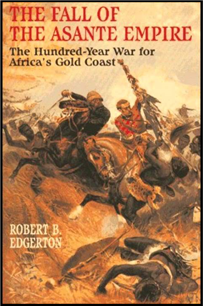 xxxxxFromxMarch
through to September, the Ashanti and their allies fought against
the British in what came to be known as the War
of the Golden Stool. Telegraph lines to
Kumasi were cut, routes to the city were blocked, and an offensive
was launched against the small garrison there. All European
residents, including Hodgson, together with about 100 native
solders, were forced to take refuge in Kumasi Fort. There they
came under prolonged attack, but during April and May
reinforcements did manage to reach the fort, increasing
the garrison to some 700, including 29 Europeans and four women.
Then in June, with supplies running low and disease rife, the
governor ordered a breakout, and 600 men of the garrison
eventually reached Cape Coast on the 10th July. A large number
were wounded, and two Europeans and 39 Hausa were killed during
the escape. Eventuallyxa relief force of
some 1000 local troops managed to reach Kumasi. It relieved the
fort and then went on the offensive, defeating the “rebel” forces
at Obassa -
xxxxxFromxMarch
through to September, the Ashanti and their allies fought against
the British in what came to be known as the War
of the Golden Stool. Telegraph lines to
Kumasi were cut, routes to the city were blocked, and an offensive
was launched against the small garrison there. All European
residents, including Hodgson, together with about 100 native
solders, were forced to take refuge in Kumasi Fort. There they
came under prolonged attack, but during April and May
reinforcements did manage to reach the fort, increasing
the garrison to some 700, including 29 Europeans and four women.
Then in June, with supplies running low and disease rife, the
governor ordered a breakout, and 600 men of the garrison
eventually reached Cape Coast on the 10th July. A large number
were wounded, and two Europeans and 39 Hausa were killed during
the escape. Eventuallyxa relief force of
some 1000 local troops managed to reach Kumasi. It relieved the
fort and then went on the offensive, defeating the “rebel” forces
at Obassa -
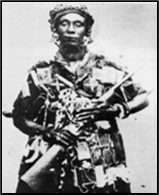
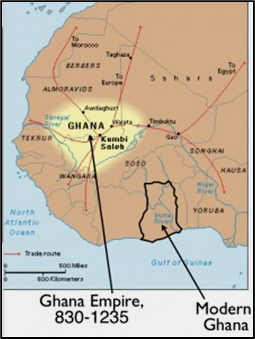 xxxxxYaa Asantewaa (illustrated) and other Ashanti leaders were then sent to join
Prempeh I on the Seychelles, and in January 1902 the Ashanti
territories were officially absorbed into the Gold Coast colony,
bringing to an end more than 200 years of independence, doggedly
achieved by a proud and resourceful people. In 1957 the Gold Coast
became the first colony to gain independence within the British
Commonwealth, and became known as Ghana, named after the medieval
Ghana Empire of West Africa (illustrated).
xxxxxYaa Asantewaa (illustrated) and other Ashanti leaders were then sent to join
Prempeh I on the Seychelles, and in January 1902 the Ashanti
territories were officially absorbed into the Gold Coast colony,
bringing to an end more than 200 years of independence, doggedly
achieved by a proud and resourceful people. In 1957 the Gold Coast
became the first colony to gain independence within the British
Commonwealth, and became known as Ghana, named after the medieval
Ghana Empire of West Africa (illustrated).
xxxxxIncidentally, Colonel Prince Henry of Battenberg, the husband of
Princess Beatrice -
Vc-


